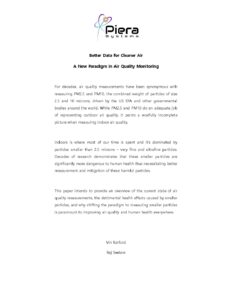For decades, air quality measurements have been synonymous with measuring PM2.5 and PM10, combined weight of particles of size 2.5 and 10 microns, driven by the US EPA and other governmental bodies around the world. While PM2.5 and PM10 do an adequate job of representing outdoor air quality, it paints a woefully incomplete picture when measuring indoor air quality.
Indoors is where most of our time is spent and it’s dominated by particles smaller than 2.5 microns – very fine and ultrafine particles. Decades of research demonstrates that these smaller particles are significantly more dangerous to human health thus necessitating better measurement and mitigation of these harmful particles.
This paper intends to provide an overview of the current state of air quality measurements, the detrimental health effects caused by smaller particles, and why shifting the paradigm to measuring smaller particles is paramount to improving air quality and human health everywhere.
Download this free whitepaper “Better Data for Cleaner Air: A New Paradigm in Air Quality Monitoring“.

